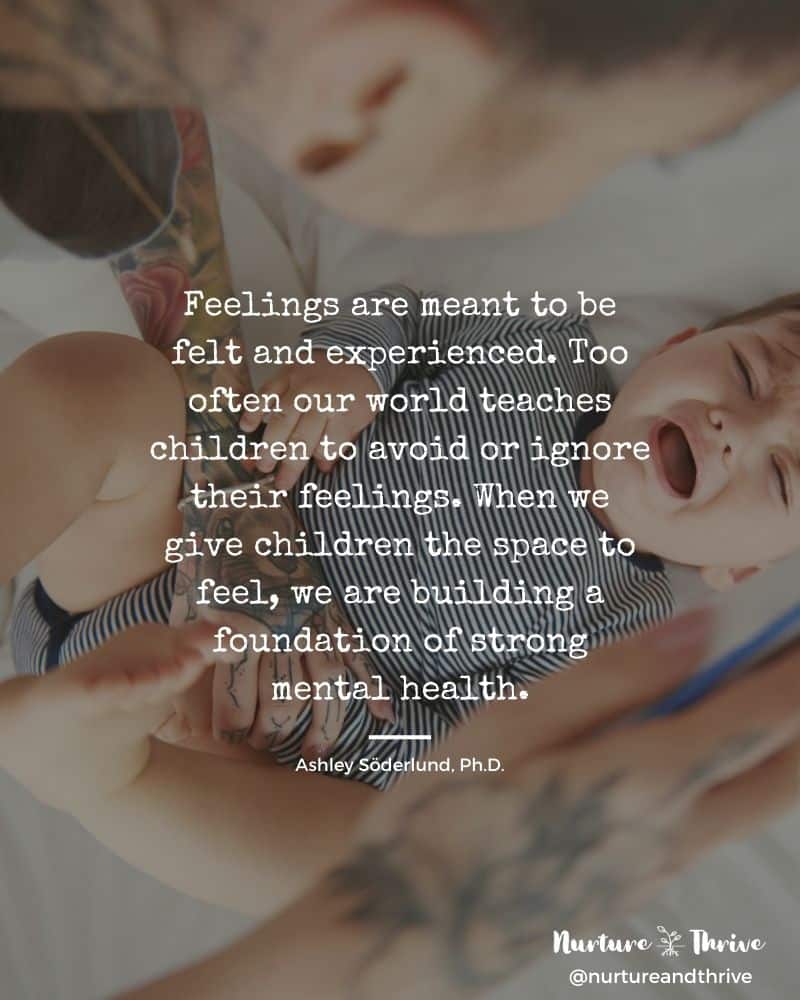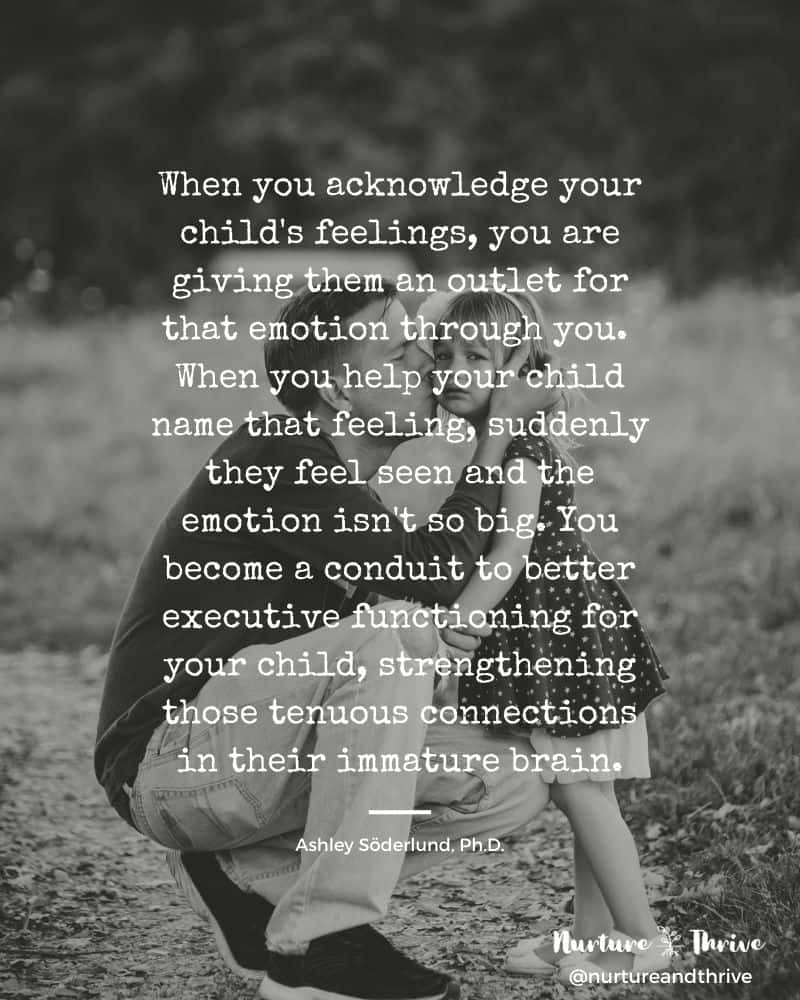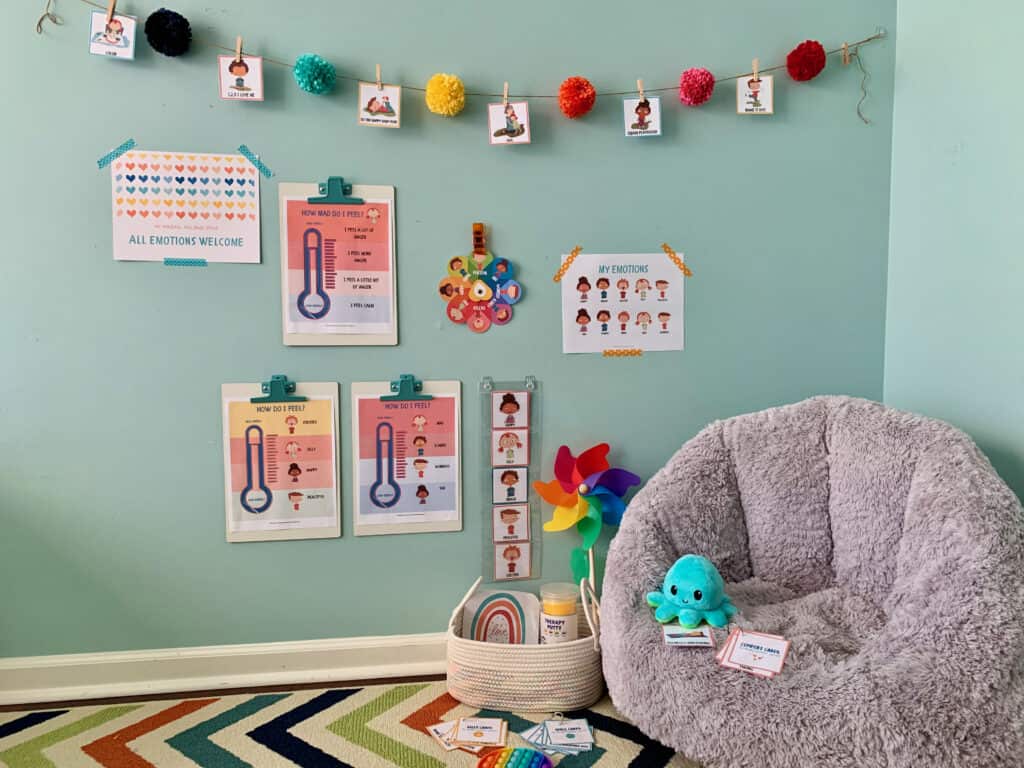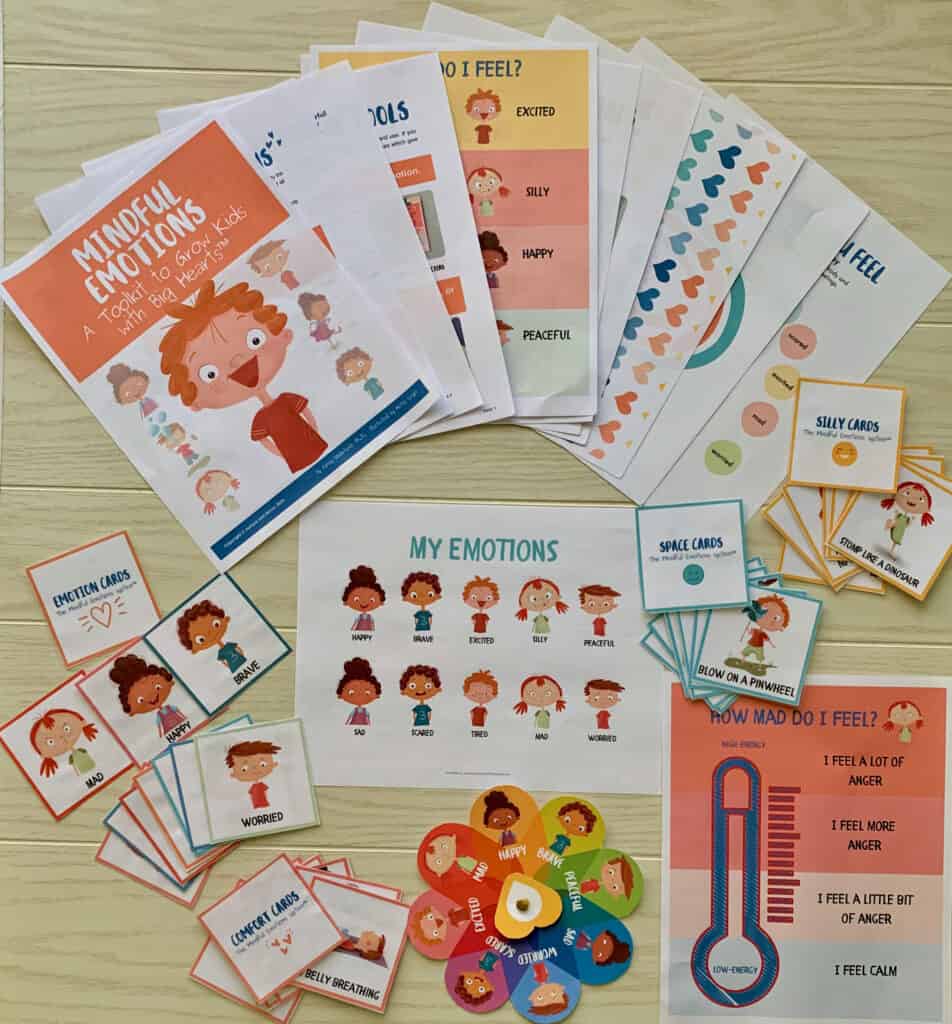Inside: 4 steps to effectively handle your toddler’s tantrums in the moment and teach them lifelong emotion-regulation skills.
You cut your toddler’s toast into rectangles instead of triangles and they lose it — there is no other way to describe it. They lose control of their actions and their emotions.
To parents, it feels like an irrational reaction to something so simple. To toddlers, their whole world is simpler and yet, quite complicated. They want attention, and they want independence. They want to explore, and they want mom or dad close by. Their brains are immature, and emotions feel really, really big inside their small bodies.
Often our reaction to our children’s tantrums and big emotions is to feel uncomfortable and stressed. After all, we were taught to control our emotions, and we feel uncomfortable with these big displays of emotions.

You might also believe that emotions are illogical and that we should control our emotions, suppress them, or avoid them.
As much as we’d like to, we can’t really control emotions. We can modulate emotions — we can learn to express emotions in better ways — but we can’t simply get rid of them. In fact, over time suppression of emotions leads to immune system suppression, anxiety, and depression (source).
The Science of Emotions: Accepting Emotions Leads to Psychological Resilience
In the theory of functional emotions, psychologists look at emotions as existing for a reason — to have a function in human existence. Think of emotions as energy with a certain quality. Like how frustration or even fear can push you to study hard for an exam. How sadness might help you reach out and connect with others.
Our first instinct when our children have big emotions is to stop the emotion, make it better, and fix it. We hurt when our children hurt.
This is especially true for big displays of emotions like tantrums.
Expressing Emotions Results in Lower Stress in the Body
Some of the research I have done examined the biological load of emotion — we asked: How stressful is emotion in the body?
We compared children who suppressed distress to children who openly expressed their distress and found that the children who suppressed their emotions had higher cardiovascular arousal and greater stress enzymes.
In other words, the biological stress or load is higher for children who suppress their emotions.
Parent Mindshift: Instead of trying to “control” our children’s emotions, help your child to learn how to express how they feel in more appropriate ways. Teach your child that emotions can be helpful rather than harmful.

The C.A.L.M. Method for Handling Toddler Tantrums
The next time your child has a meltdown, see their smallness. See how their emotions are bigger than they are. And in that moment of truly seeing them, you will empathy rather than exasperation.
Ashley Soderlund
Cool Breaths and calm body (Put Your Oxygen Mask on First)
Recognize that your child is having a tantrum and that tantrums are a normal part of development (for more about tantrums and brain development, click here). This is your child’s immature way of expressing their emotions. It is also completely natural for you to experience stress in response to your child’s tantrum. Accept that you are feeling stress — name your stress — and take 1 or 2 deep and grounding breaths.
If you think your child is feeling sensory overload or emotional dysregulation, focus on helping them calm down their nervous system first. Long strokes up and down their arms, a firm hug, holding and rocking, and deep breathing if they are able (Is it a tantrum or a meltdown?)
The best way to reduce tantrums is to prevent them by anticipating what triggers your child, like being tired, hungry, frustrated, or over-stimulated. For more on preventing tantrums, click here.
Acknowledge and Accept the Underlying Emotion or Need
Help your child to notice how they feel and label that feeling. When you do this, you are helping your child recognize the sensation of anger, worry, or sadness and to be able to name it.
Naming the emotion makes it less overwhelming because it is identified as an emotion — not who you are. Not as something controlling you. Not as something that will last forever. Naming the emotion demystifies it and lets it move through and out of the body.
This step alone is so powerful for kids of all ages.
Children are still learning to identify their emotions, so helping them name their feelings will help them feel understood — to feel seen. By naming how they feel, they also acknowledge that feeling without trying to change it or avoid it — a keystone of emotional intelligence.
They simply notice the emotion as a part of themselves.
In this step — do not say: “You are mad.” Instead, say, “I notice that you are feeling some mad feelings.” Or, “it seems like part of you is feeling angry,” or “do you notice that you have a big feeling inside?”
This way, the emotion is something to notice, not who they are.
Let Your Child Make a Choice
Let your child share how they feel and listen to what they say. Do they push away when you offer a hug? Do they respond better to a deep breathing game, or maybe they need to stomp around like a dinosaur to release some frustration?
Some children need a little space to calm their over-stimulation. Some children want comfort, and some children respond well to silliness. These are all ways that children use to reset or recenter — to regulate themselves. You can help your child by asking them if they want comfort, space, or silliness. Consistently offering these three things will help your child build a healthy foundation for self-regulation.
After you help your child name and notice the emotion, you allow them to feel it and reset.
Resetting or recentering is a step we often miss in helping our children manage emotions — but coming back to yourself can help strengthen your child’s sense of self — their core beliefs about themselves, security in themselves, and their confidence or self-efficacy.
Move through the emotion and move on
It is so important for children to learn that emotions are something meant to be felt and not suppressed. Comfort, space, and silliness regulation methods can help your child work through their emotions.
Once your child is feeling better, help them notice that they felt the emotion and now that emotion has moved on. Children often think that each emotion will last forever.
Printable Emotions Toolkit for a Calm Down Corner
My Mindful Emotions Toolkit includes an Emotion Poster, Emotion Cards, Emotion Wheel, and Emotion Thermometers. The thermometers help your child to begin to think about emotions as energy as well. You can see more here: Mindful Emotions Toolkit for Kids. Included in the toolkit are 21 regulation cards divided into the categories of Comfort, Space, or Silliness™.
An Example: C.A.L.M. Method for Toddler Tantrums
You are in the parking lot, and your 3-year-old wants to run. You scoop her up, and she starts to hit, flail, and scream. She is mad because her impulse to run has been blocked.
As your child is flailing in your arms, you first take a deep breath to yourself and realize it is okay to feel stressed. You model some deep breathing and say:
“It is okay to feel angry, but not to show your anger with hands and feet. Are you feeling angry?”
Your child replies with a wail of frustration, but the flailing stops with your acknowledgment and your calm breathing:
“That sounds like a mad sound! Running here is unsafe, and I will keep you safe. You can choose if you want comfort, space, or silliness.”
Your child says — “I feel mad! I want to be silly!”
“Okay, silly faces while we get in the car seat. Let’s go!”
Building a Foundation for Emotional Intelligence
This deceptively simple strategy helps your child develop a strong foundation for emotional intelligence. With the C.A.L.M method, children will learn that:
- Emotions are just a part of them- they are not who they are.
- Feelings come and go.
- Once they recenter, they see that they have self-energy separate from emotional energy.
- Our feelings can be a message about what we might need or need to learn.
- Emotions are not scary. We can experience them and send them on their way.
With this method, you are doing two powerful things: Honoring your child’s feelings and giving your child a way to regulate emotions. And you can do this anywhere! Even in a parking lot!
This system works for both younger and older children. Younger children are learning to identify emotions and make a choice that feels right for them. For older children, the system helps them realize emotions are just one part of them and that they can choose how to respond and then recenter.
Your child will not always be able to do all of these steps. That is perfectly and developmentally normal. Children will struggle to identify their feelings, and the emotions may be so big it is hard for them to choose comfort, space, or silliness.
In these moments, use a Feeling-Break time-in and help scaffold these skills using tools and printable prompts.

With consistent use over time, your child can use these strategies on the fly without tools or prompts! By consistently guiding your child through this method, you will build a foundation of healthy emotion regulation that will serve them their whole life.
These practices lead to awareness of our emotions. Being mindful of our feelings leads to being able to respond rather than react.
Mindfully experiencing emotions means we recognize our emotions, pay attention to them, and acknowledge that emotional energy, stuffing down inside, is no longer needed. And without needing to “control” your child’s emotions, your own stress and biological load will also be lifted.
Mindful Emotions: A Toolkit to Grow Kids With Big Hearts
- Printable Feelings Wheel for Kids to Support Their Emotional Development
- Your Two-Year-Old’s Developmental Milestones and Tips to Support Their Growth
- The Definitive Guide to Understanding and Handling Tantrums and Meltdowns
- Get Started with Positive Parenting Today: 10 Tips From a Developmental Psychologist
- 4 Types of Parenting Styles in Developmental Psychology and Why It Matters
What to do next…
1. Get advice from Dr. Ashley Soderlund sent right to your inbox. ❤︎
2. Emotional and mental wellness begins at home.
Get the tools you need in my shop! Digital printables you can instantly download and print to foster connection, emotion regulation, and more! Check out the Nurture and Thrive Shop.



 “Time-out” vs. “Time-In”: Is There a Better Way? Why You Need the Flexibility of a Feeling-Break
“Time-out” vs. “Time-In”: Is There a Better Way? Why You Need the Flexibility of a Feeling-Break